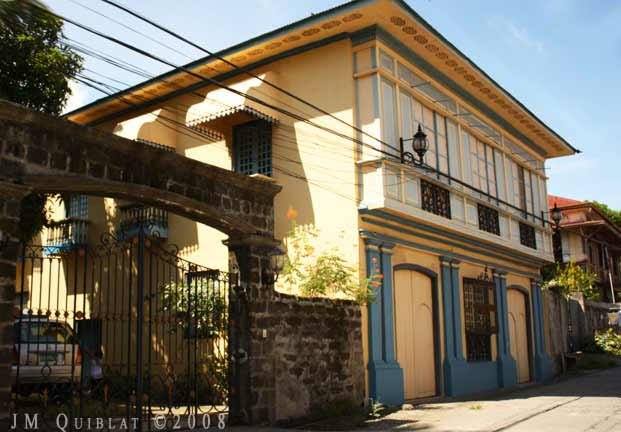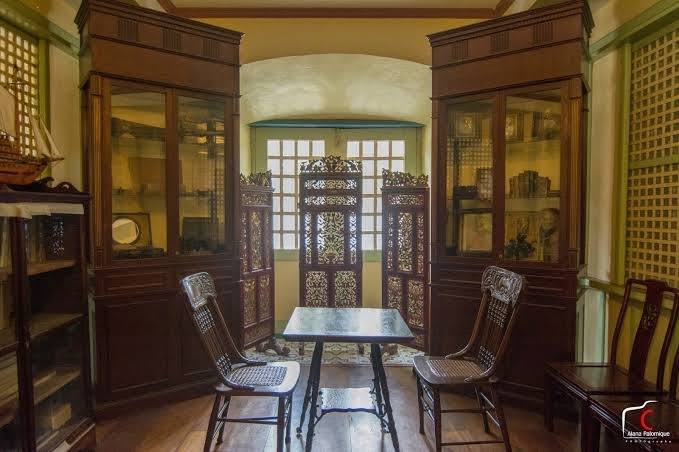BUILT IN 1870 BY DON EULALIO
VILLAVICENCIO y Marella, the house was presented to Dona Gliceria Marella y
Legaspi on the occasion of their marriage in 1871. Hence, it came to be called “The Wedding Gift
house.”
The couple lived in the house
until the death of Don Eulalio’s parents who left him the adjoining house.
Since it was bigger, the couple moved over to the older house to accommodate their
growing family.
The Wedding Gift House then
served as a guest house. The Luna
brothers stayed there in January 1892 while soliciting contributions throughout
Batangas for the Propaganda Movement.
The Villavicencio couple donated Php18,000 to the cause, a sum
equivalent to Php6.5 million today. In gratitude, Juan Luna gifted the couple with their portraits which were
subsequently framed in beautifully carved and gilded frames by Isabelo Tampinco.
Don Jose Villavicencio, Don
Eulalio’s son, lived in the house with his wife Micaela Atienza until his death
in the 1980s. Since they were childless,
the house was occupied after his death by one of his wards who converted it
into apartments, with an entire family occupying each room. For a while, the house even became a toy
factory.
In the communal partition the
house went to the heirs of Dona Vicenta Villavicencio de Villavicencio,
Gliceria’s eldest daughter. Monserrat
Villavicencio Joven, Vicenta’s eldest child, inherited the house. Her daughter Jocelyn Villavicencio Joven and
her husband, Advinculo Cuay Quiblat, are the present caretakers of the house.
Since the Wedding Gift House was
separated from the main house by a garden, Don Eulalio built a GI-roofed wooden
bridge to connect the azateas of rear terrace of both houses to
facilitate interaction between the two Villavicencio houses. His family could visit thus his parents without
having to go out into the street. Unique
in the country because of its corrugated roof, the bridge stood there until the
1990’s, when its dangerously derelict condition called for its demolition.
A real three-bayed bahay na
bato painted in the original indigo blue and yellow ochre, the walls of the
entire house, including that of the second floor except for the front, are
built of adobe blocks. A wooden volada
or “flying balcony” on the second floor fronting the street is walled with carved
molave panels and wall-to wall
sliding capiz windows topped by multi-lobed exterior transoms, also of capiz. Above the upper window sill are decorative
slats, where Japanese lanterns were hung during processions. Ventanillas or “little windows” beneath
the pasamano or window sill are faced with iron grillwork wrought in the
palmette motif with cast-led ornamentation typical of the 1870s. The neo-Gothic ogee arches carved on the main
double doors replicated those in the older Villavicencio House.
The house is unusual because the
two main double doors to the zaguan are built on either side of a
central bay sporting a large decorative wrought-iron grille with a palmette
motif decorated with cast-lead
ornaments. The left door led to that
part of the zaguan where the carruaje or carriage was kept when not in
use. A door on the left opened to the central garden with a stone stairway at
the end leading up to the azotea. The caballeriza
or stable was located under the azotea. The
left zaguan door also served as a tradesman’s entrance to the large and
spacious concerns of the Villavicencios.
French doors on the street side let light in, while sliding the capiz
windows on either side of the entresuelo ensured good cross-ventilation. The main door or puerta mayor on the
right was for the exclusive use of the family and their friends. It opened an airy zaguan tiled with azulejos,
handpainted decorative tiles imported from Spain that also paved the stairs
leading to the meseta. A door to
the right of the meseta led to the garden that separated the house from
its neighbor.
The Villavicencio-Marella House
has many features. Aside from being the
only one in Taal where the zaguan is floored with azulejos, it is
one of a handful in Batangas, where the formal rooms have French doors opening
to the balconies also floored with azulejo tiles. The turned and carved kalabasa or
squash-shaped balusters so typical of Taal were repainted in the original
primary colors. This is the only house in the country where the rejas na
buntis is overlooking the garden.
The unusual louvered doors with delicately carved transoms of the
bedrooms made for better ventilation and air circulation. They were probably inspired by those in the
newly reconstructed Ayuntamiento building in Intramuros.
When the rooms of the house were
converted to apartments after his death, the house became derelict. Leaks in the roof had rotten some of the
floorboards and many posts had sunk due to wood rot. The dining-room floor sagged dangerously at
one end so that the room could not be used.
By 1990, the house had fallen into disrepair and only half of it was
habitable.
It was the only when the house
was inherited by Monserrat Villavicencio de Joven that her daughter Jocelyn
Villavicencio Joven and her husband Advinculo Cuay Quiblat decided to restore
the house to its former glory. The
sagging and leaking roof was repainted, the posts were jacked up and
reinforced, and the rotten floorboards replaced. With the help of Martin I. Tinio Jr., a very
close friend, the walls of the upper floor were painted in the style of the
1870s, using colors typical of that period.
The garden was landscaped with plants mentioned in the third edition of
F. Blanco’s book Flora de Filipinas that was published in 1883. A gazebo in the 1890s-style was built in the
garden. The process took six years, but
the house is now a delight to the beholder. MARTIN I. TINIO
Full text credit to Martin I. Tinio
Credits to original photo owners








